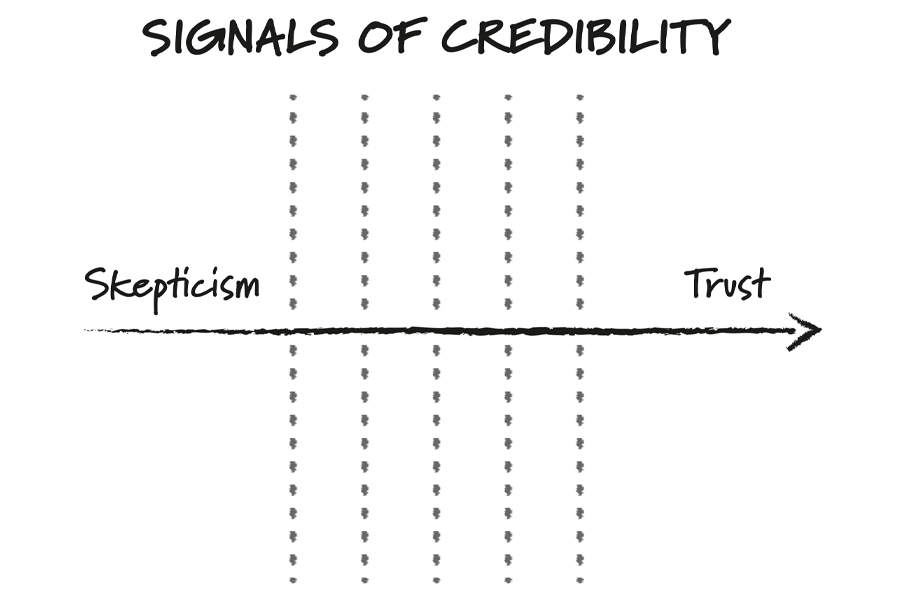

It's been said that trust is like a bridge. Brick by brick, it’s built and then reinforced. Every time we deliver on something we promise, we add a brick between us and the person trusting us.
Adviser-client relationships are unquestionably built on trust. And advisers who build strong and sturdy bridges become the go-to advisers.
Of course, building trust takes time — there’s no shortcut to proving trustworthiness.
Or is there?

While it’s true that trust must be earned, there are ways to help accelerate the trust-building process. I call them “signals of credibility."
Marketing gets a bad rap for making outlandish claims to drum up new business. While that strategy may work for some (although not for long), I encourage you to embrace the opposite: Be realistic.
Be upfront about what working together will look like. Should they expect immediate results? How much effort will be required on their end? Where are the common failure points? The more open you are from the get-go — even about what challenges will be faced — the faster you’ll earn trust.
First impressions and details matter. Misspelled words, poorly written copy or a slow-loading website can undermine trust — and ultimately, your influence. Such missteps send a signal that basically says, “If we can’t get the little details right, we certainly won’t be able to help you with more important things.”
Producing error-free, high-quality content requires significant focus and effort. If writing, web design, graphic design and social media aren’t your forte, consider hiring others to handle those tasks.
Getting such first impressions right show that you care about details and can be trusted.
In many ways, reviews are the currency of the internet. People read reviews on everything from light bulbs to lawn mowers — advisers are no different.
Ask your clients to write reviews. Prioritize Google, but Facebook and Yelp are important, too. Encourage clients to use employees’ names. The more details a review includes, the more authentic it reads. Everybody can spot a fake review.
And don’t stop there: Amplify all your reviews — new and existing. Share them on social media, screenshot emails or texts that praise your firm, and include testimonials on your website. Of course, you’ll want to ask permission from the client first and remove any personal or identifying information (and make sure you follow the Testimonial Rule guidelines).
The most authentic reviews are unsolicited. You don’t ask for them, they just happen naturally — especially when existing clients interact with prospects.
“When would that happen?” you ask. Client events are a great environment for this interaction to occur. Invite as many current clients as prospects. The clients will recognize the special treatment, and they’ll have a chance to interact with prospects and share their experience working with you.
On a smaller scale, one of my favorite tactics is scheduling alternating client and prospect appointments. That way you create an organic situation in which your clients and prospects are bound to cross paths as one meeting wraps up and the next begins. All you need to do is introduce them. Rinse and repeat!
Public relations empowers you to control the narrative about your firm. It’s an extension of marketing that gets your name in front of your audience.
PR requires you to build rapport with journalists. You become their go-to on certain topics and they will reach out to you for a quote or interview. In turn, you can share every publication or article you and your firm are featured in on your website and social media. You’ll be seen as an expert and reputable source.
You should also showcase your PR efforts and positive feedback in your physical office, whether that's your firm’s hallway, lobby or conference room. Print, frame and hang articles that feature you, as well as photographs of you with happy clients.
These examples put in a good word for you, building your reputation without saying a word.
Cultivate an intimate adviser-client relationship by starting on equal ground. Meet around a small round table in a comfortable space that feels more like a home than a cold office. Swap out the glaring fluorescent lights with warm lamps. Keep photos of your family nearby. Make sure the chairs are soft and at the same level. Comfort and equality breeds trust.
I encourage advisers to use the PAS method in client meetings:
• P = Problem
• A = Agitate
• S = Solution
Mutual understanding builds trust. Before you can solve a problem, you need to understand it. To find the root cause of money goals, ask questions like “What money issues keep you awake at night?” and “Why did you schedule this meeting with me?”
“Agitate” refers to digging deeper into their initial answers. Ask them to expand on answers and describe how a situation makes them feel. A few well-timed questions can take the conversation from casual to real talk, building trust and improving your understanding of your client.
By implementing these eight methods with prospects and clients throughout your relationship, you will build and reinforce trust. A prospect will become a client, and a client will transform into a raving fan who tells everyone about you.
And it all starts with trust — brick by brick.
Robert Sofia is CEO of the digital marketing firm Snappy Kraken.

Relationships are key to our business but advisors are often slow to engage in specific activities designed to foster them.

Whichever path you go down, act now while you're still in control.

Pro-bitcoin professionals, however, say the cryptocurrency has ushered in change.

“LPL has evolved significantly over the last decade and still wants to scale up,” says one industry executive.

Survey findings from the Nationwide Retirement Institute offers pearls of planning wisdom from 60- to 65-year-olds, as well as insights into concerns.
Streamline your outreach with Aidentified's AI-driven solutions
This season’s market volatility: Positioning for rate relief, income growth and the AI rebound
